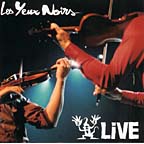Les Yeux Noirs / Live

Les Yeux Noirs / Live
Zamora Productions 468019, 2003
If there are two European folk musics that cry to be played together, surely it is a fusion of Eastern European Jewish music and that of the Rom. As Zev Feldman writes in his landmark "Bulgareasca/Bulgarish/Bulgar: The Transformation of a Klezmer Dance Genre", the two groups commonly played together and had both an evolved common repertoire in addition to their separate music. Add in the music and inspiration of the most famous Rom guitarist of them all: Django Reinhardt and you have something that, in these hands, results in an energetic, propulsive, amazing sound.
From the opening "Cioara" with the twin fiddles and concert-sized tsimbl, the band never wavers. This is simply amazing world music from the wilds of Romania as transformed by classically-trained French musicians who get it, in a big way. But the transition from that wildness to a gently sung "Rozinkes mit mandlen" shows that the band gets it more deeply than just wild violin playing. It is also fascinating to hear how common dance patterns repeat themselves. Thus, the abrupt change between "Joc de loop" to "Calusul" and as that song proceeds, as though playing to a gradually speeding up dance set. But for the Rom music, this could be a Jewish wedding!
The band's addition of a hard rock edge to "Yiddishe Mame" does a lot to rescue that song from maudlin (albeit, perhaps not enough). On the other hand, combining "Balamouk" with "Ot Azoi" really drives home how close the Rom and Jewish music are. By the time the band gets to "L'Alouette," the intensity is heart-stopping, so the band stops for a few seconds of silliness before resuming to burn up the fiddle and tsimbl strings and moving into "Danse du sabre" with themes that will sound entirely familiar to American bluegrass fans. Returning after a short audience poll to the wild vocals of "Guene Roma" the band refuses to let up. If not for the coda bonus track, a recording of "Lluba" with a children's chorus, I'm not sure what the listener would be expected to do.
Overall, this is one of the most exciting groups that I have heard on disk in many years. Now to figure out a way to get the band to appear here on the East Coast. Until then, this disk is the next best thing.
Reviewed by Ari Davidow, 6 Feb 2005
Personnel this recording include:
François Perchat: cello
Constantin Bitica: accordion
Éric Slabiak: violin & vocals
Pascal Rondeau: guitar & vocals
Aidje Tafial: percussion
Olivier Slabiak: violin & vocals
Franck Anastasio: bass & vocals
Marian Miu: cimbalom
Songs
- Cioara (Les Yeux Noirs) 4:33
- Sanie cu zurgale (trad.; arr. LYN) 3:33
- Rozinkhes (Abraham Goldfaden) 2:37
- Joc de loop (LYN) 2:19
- Calusul (trad.; arr. LYN) 2:32
- Lluba (trad.; arr. LYN) 4:50
- Hora ca la caval (arr. LYN) 2:41
- Cymbalum (arr. LYN) 3:33
- Yiddishe Mame (lyrics: Lew Pollack; Music: Jack Yellen; arr. LYN) 4:41
- Balamouk (LYN) 5:26
- Ot azoi (trad.; arr. LYN) 4:28
- Djelem (trad.; arr. LYN) 4:12
- Liebkeit—tenderness (Lyrics: N. Roux; Music: H. Giraud; arr. LYN) 3:01
- L'alouette (trad.; arr. LYN) 4:13
- Danse du sabre (Aram Katchaturian, arr. LYN) 2:21
- Guene Roma (trad.; arr. LYN) 3:09
- Tchaye (trad.; arr. LYN) 4:29
- Lluba (trad.; arr. LYN) 4:46

